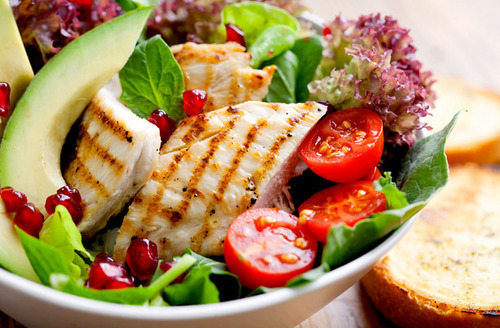
Chances are your schedule is already so loaded that you cringe at the thought of trying to add another item. Having a set meal plan, however, can make it easier to lose or maintain weight. There’s no need to set an alarm, though: Check out these easy-to-follow eating menus to find the one that works best for your goals, lifestyle, and food preferences.
EATING 3 SQUARE MEALS
The classic breakfast, lunch, and dinner routine can be effective for weight loss when each meal is big enough to leave you satiated, but your daily total calorie intake is lower than what you’d eat chowing down five times a day. It’s also important to consume at least 30 grams of protein at each meal to maximize protein synthesis, a key strategy for protecting your hard-earned muscle while dieting. This meal structure can effortlessly translate into weight maintenance, as it follows social norms and is thus easily adoptable.
Works best for: Those who have a rigid work schedule that only allows for breaks at traditional set times, leaving no chance of escaping their desks for a mid-morning protein shake.
EATING 4 TO 5 SMALL MEALS
Very popular with people trying to drop pounds, this dining arrangement calls for reducing the size of the meals that you would normally eat and adding one or two small snacks throughout the day. If you’re looking to maintain the reading on the scale, the multiple meals will help manage satiety and provide a balance of calories throughout the day.
Works best for: This one's for you, snackers, as it transforms your freestyle eating into a plan, helping you better account for calories without drastically changing your way of eating. These “mini meals” are also smart for people with reactive hypoglycemia, a condition where your blood sugar levels drop too low shortly after eating. Munching more frequently helps prevent these dips and the subsequent feelings of shakiness, dizziness, or general brain fog.
EATING AROUND YOUR WORKOUT
Exercise increases insulin sensitivity, enhancing your muscles’ desire and ability to take up carbohydrates. If you want to ensure that your carbs are shuttled to your muscles to fuel recovery, try this agenda, which is one of the more biochemically sound approaches to eating: Consume all your carbs for the day during and after your workout, whenever that is. The rest of the day focus on protein-rich foods, green vegetables, and fat.

Works best for: Anyone looking to lose weight or stay lean while still being able to eat larger amounts of healthy starchy and grain-based carbs.
VEGAN BEFORE 6 P.M.
New York Times writer Mark Bittman made this approach popular when he used it to lose 35 pounds. According to Bittman, from the time he woke up until dinner he ate fruit, vegetables, whole grains, and legumes. Then he had whatever he wanted, which, he’s said, was normally “quite indulgent.” Going sans animal products most of the day restricts your food choices to relatively low-calorie options so you can eat fairly freely come dinner and still wind up with a low calorie count overall at the end of the day.
Works best for: People who don’t mind a more-limited food selection during the day and have enough self-control not to overindulge with excessive calories after 6.
FASTING TWICE A WEEK
A straightforward strategy popularized by Brad Pilon’s book Eat, Stop, Eat, all you have to do here is not eat for 24 hours two days a week—then you can eat freely (in moderation, of course) the other five days. Not only for weight loss, this method of fasting can also help you maintain your figure if you adjust the total time you are fasting each week (less fasting for weight maintenance and more for weight loss).

Works best for: While the idea of having anything you want when you can eat is appealing, be sure you’re also okay not eating for long periods of time.
NO EATING AFTER 8 P.M.
Let’s get one thing straight: Putting the kibosh on noshing past a certain time has nothing to do with some magic fat-burning hour. Establishing a no-food time frame can simply help cut down on late-night mindless calorie consumption. The trick is to be sure your evening meal isn’t the smallest of the day and that it includes adequate protein and fiber to help outwit potential hunger pangs that may arise before bed.
Works best for: Nibblers who can’t stop snacking after dinner has been cleaned up.
Source
0 Response to "The Best Time to Eat to Lose Weight"
Post a Comment